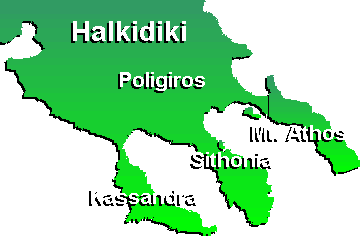ABOUT HALKIDIKI
Halkidiki is a peninsula, southeast of the city of Thessaloniki (Greece's second largest city), with its
characteristic three peninsulas (Kassandra, Sithonia, Athos), it resembles a trident piercing the
Aegean.
Sunny, golden sandy beaches. Deep and picturesque gulfs. Traditional villages and modern tourist resorts. Small islands and
sheltered bays. Pine-clad hills descending to the sea. Mediterenean climate and magnificent natural beauty. This is today's Halkidiki.
HISTORY
Inhabited approximately 700,000 years ago, as revealed by the foundings from the prehistoric area of Petralona. Neolithic villages and
villages from the Copper Period were located in the west and central Halkidiki, many cities flourished, among which "Olynthos" was the most
popular one (arcaeological sites of Olynthos, Potidea, Stagira, Toroni).
In 384 BC Aristotle, the great philoshopher and Alexander the Great's teacher, was born in Stagira. Halkidiki took its name from city of
Chalkis, located in Euboa, that colonized it in the 8th and 7th century BC. Kassandra took its mane from Kassandros (King of Macedonia) ,
Sithonia from Sithon, a son of God Poseidon and Athos was named after a giant called Athos. In the 9th century the first monastic communities
were established in Athos. Today, the monastic state of Athos (also called "Holly Mountain"), is a shelter of Byzantine monasteries, caves,
monks, prayers, a "mountain-church" for the thousand-years Christian Orthodox religion.
No matter where you go, Halkidiki cannot fail to please you. Throughout, an effort has been made to develop tourist facilities that are
in keeping with the natural surroundings. Most of the hotels and private homes in the area are built in the traditional Macedonian style,
designed to enhance rather then detract from the environment. In planning for tourism, the people of Halkidiki have tried to make their resorts
as appealing and as ecologically sound as possible.

|